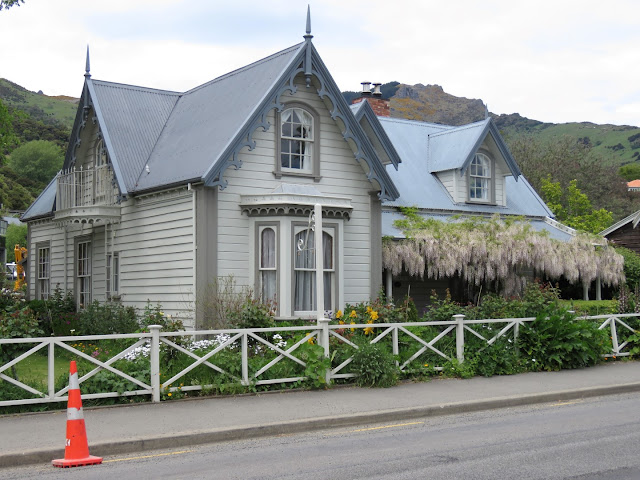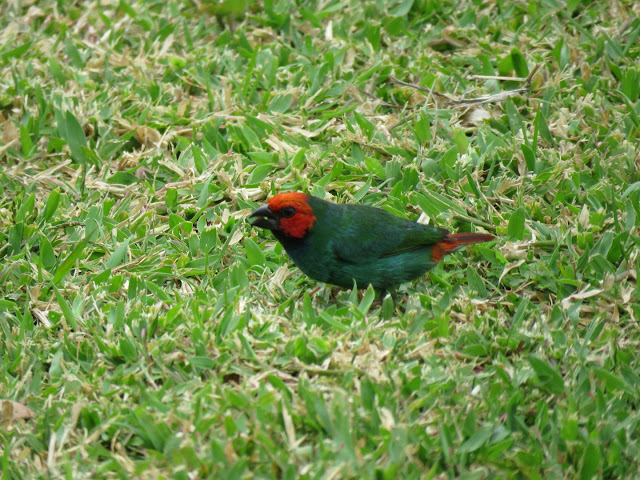Little
Blues are the smallest species of penguin. They grow to an average of 33 cm (13 in) in height and 43 cm (17 in) in length. We were able to see them
close up, like this one, at a rehab facility in Napier, New Zealand. In the wild they are
very shy and will dive out of sight at the slightest movement or noise. So, it
was great when were also able to see many more of them in the wild, at Akaroa,
from the deck of a sailboat touring the harbour. Napier and Akaroa were just two
of the seven ports we would visit in New Zealand during the last week of our
six week cruise on the MS Noordam. It
was a very busy week with a new port every day. But, first we had to get there.
We left
Hobart, Tasmania, headed across the Tasman Sea to Milford Sound. We had left port
early due to an impending storm. In a small boat, we would have stayed in
harbour. On the big cruise ship we left early. The captain was hoping that we
would stay ahead of the worst of it and of course we had our schedule to keep. It
was a full-blown Beaufort Force 10 storm. The winds hovered between 50-55 knots
for two straight days. There were gusts to 74 knots and probably above. The
ship was battened down, the swimming pools were drained, all exterior doors
were locked, all outdoor furnishings were lashed, all passengers were warned to
lock and not open their stateroom doors. It never looks as bad when
you’re a long way up from the waves and at least they seemed to be all going in
the same direction which helps a lot. We were on the leeward side of the ship and with the
stabilizers out the boat movement was very manageable with just a shudder and a
wiggle as a rogue wave would strike the hull out of pattern. Sleep wasn’t an
issue for us and we slept soundly through it all. There were fewer people about the ship and the dining room was definitely
very quiet for dinner. On the third day the winds lessened to the
high forties. There was some doubt that we’d be able to enter Milford Sound,
but, we got in through this narrow entrance.
It was grey, wet and misty, but, very atmospheric and
beautiful. The waterfall at the head of the Sound was impressive. For scale, look at the three kayaks at the bottom of this photo.
We read in a local paper a few days later that, while we were in Milford Sound, a passenger had been taken off by boat and airlifted by helicopter to a local hospital. We had seen the boat and helicopter, but, hadn't made the connection. During our six week voyage, there had been at least one death.An Australian man died just two days out from Sydney. We were often met at the dock by one or more ambulances waiting to pick up passengers for medical treatment.
Being in
a new port every day was exhausting and after a while they all started to blend
together, but, there were highlights. We were quite taken with Napier and Dunedin and there’ll be separate
posts on each of those soon. Wellington, the capital of New Zealand, was really
just another big city, but, they do have a very good botanical garden where we
photographed this gorgeous water lily.
Two of
the smallest towns we visited, Picton and Akaroa, were both very charming. The
people of Picton were very welcoming. Two ladies from the town were standing by
the gangway handing out small, perfect, fresh flower corsages as we came
ashore. It was a nice touch. Picton also has a good harbour where the
Interisland ferry docks and a nice park alongside.
We hiked
to the top of the local lookout and were rewarded with this lovely view over
Picton, its harbour and out to Marlborough Sounds beyond.
Akaroa
is a newer destination for the cruise ships. They used to go into nearby
Christchurch, but, due to the destruction of the port facilities there in the
earthquake of 2011, Akaroa has become the replacement choice. It’s a tiny
place, with a surprising French influence that has descended from the earliest
settlers to the region. The harbour is shallow and our large ship had to anchor
off and we were tendered in. It was a long way in and around this headland.
The
visit was somewhat marred as there was another cruise ship in port and the
influx of passengers just filled up the little town to bursting with swarms of
people milling about. It wasn’t a good thing and you have to wonder why
landings couldn’t be coordinated better. To get away from the crowds and
salvage the visit we went out on a two hour harbour tour on a classic sailing yacht (www.aclasssailing.co.nz). It was a beautiful, sunny sailing afternoon
with just enough wind for a relaxing sail. We spotted some of the resident blue
penguin colony. We had hoped to see Hector’s dolphins, the very rare and
smallest member of the dolphin family, but, it wasn't our day. Before joining
the queue to return to the ship we walked around the town and found it a
delightful place.
We
didn’t even get off the boat in Tauranga as it was a short stop and we needed
to pack for our ship departure the next day in Auckland. It was also a
miserable day with torrential rain and heavy fog, unlike the great weather we'd had in all the other ports. We are planning to visit Tauranga and nearby Rotorua in depth on our three month campervan road trip, so, didn’t miss
anything.
The next
day we arrived at our final port of call, Auckland, after six weeks aboard. We were the first to
disembark and we were off! It felt good to be back on land and
making our own travel and food choices once again.




































